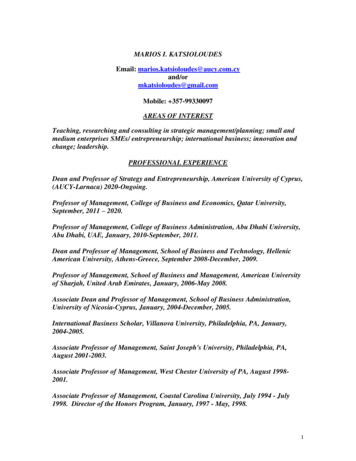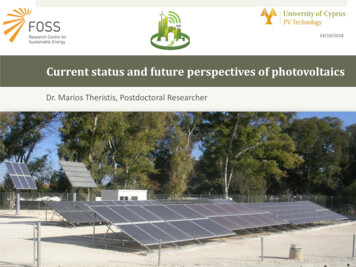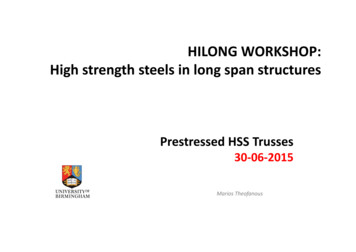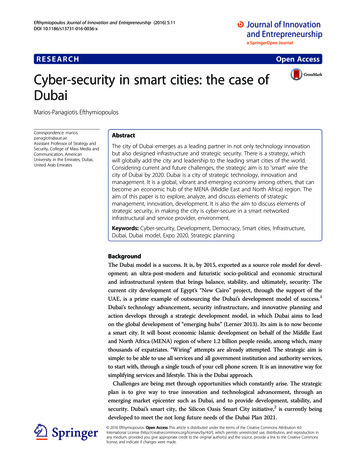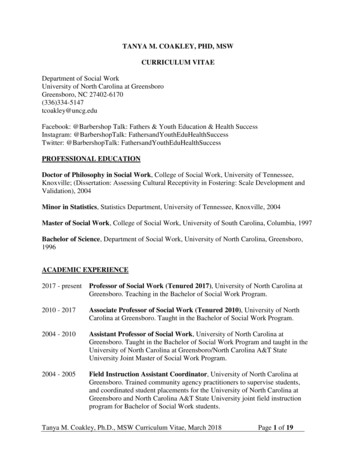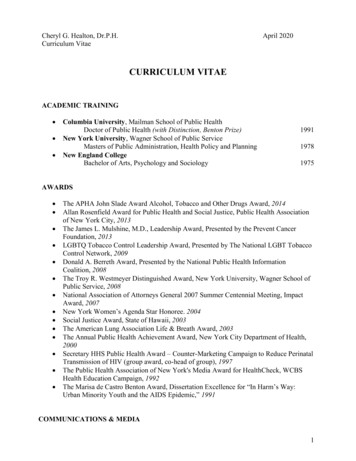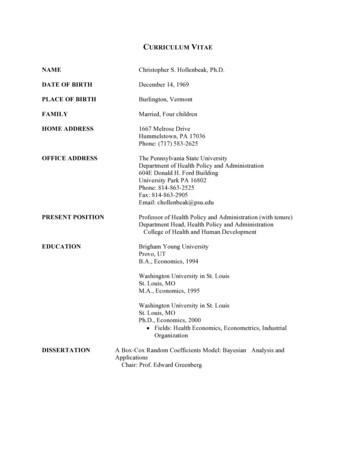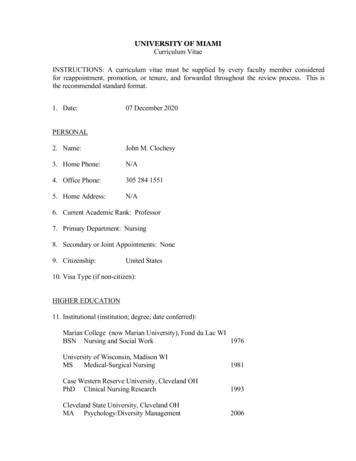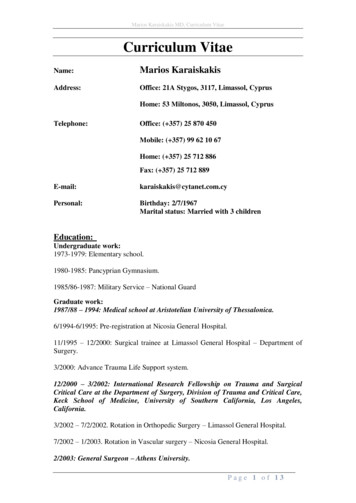
Transcription
Marios Karaiskakis MD, Curriculum VitaeCurriculum VitaeName:Marios KaraiskakisAddress:Office: 21A Stygos, 3117, Limassol, CyprusHome: 53 Miltonos, 3050, Limassol, CyprusTelephone:Office: ( 357) 25 870 450Mobile: ( 357) 99 62 10 67Home: ( 357) 25 712 886Fax: ( 357) 25 712 day: 2/7/1967Marital status: Married with 3 childrenEducation:Undergraduate work:1973-1979: Elementary school.1980-1985: Pancyprian Gymnasium.1985/86-1987: Military Service – National GuardGraduate work:1987/88 – 1994: Medical school at Aristotelian University of Thessalonica.6/1994-6/1995: Pre-registration at Nicosia General Hospital.11/1995 – 12/2000: Surgical trainee at Limassol General Hospital – Department ofSurgery.3/2000: Advance Trauma Life Support system.12/2000 – 3/2002: International Research Fellowship on Trauma and SurgicalCritical Care at the Department of Surgery, Division of Trauma and Critical Care,Keck School of Medicine, University of Southern California, Los Angeles,California.3/2002 – 7/2/2002. Rotation in Orthopedic Surgery – Limassol General Hospital.7/2002 – 1/2003. Rotation in Vascular surgery – Nicosia General Hospital.2/2003: General Surgeon – Athens University.Page 1 of 13
Marios Karaiskakis MD, Curriculum VitaePositions Held:1. 6/2014 – present. General Surgeon at Ygia Polyclinic Private Hospital2. 6/2003 – 6/2014. General Surgeon at the Achillion Private Hospital.3. 9/2004 – 7/2009. First Assistant Surgeon for the Cardiothoracic Department atthe Lemesos Medical Center. Head of the Department was Dr. Omiros ArtemiouCardiothoracic Surgeon (on 7/2009 the Department was closed for financialreasons).4. 7/2002 – 1/2003. Rotation in Vascular surgery – Nicosia General Hospital.5. 3/2002 – 7/2002. Rotation in Orthopedic Surgery – Limassol General Hospital.6. 12/2000-3/2002. International Research Fellowship on Trauma and SurgicalCritical Care at the Department of Surgery, Division of Trauma and Critical Care,Keck School of Medicine, University of Southern California, Los Angeles,California.7. 11/2000 – 12/2000. Rotation in Orthopedic Surgery – Limassol General Hospital8.Surgical training for Specialty in General Surgery – Limassol General Hospital11/1995-11/2000.9. Pre-registration house officer 1994-1995 (6 months general surgery and 6 monthsgeneral medicine) Nicosia General Hospital.Areas of Concentration/ Research Interests:General SurgerySurgical OncologyTraumaSurgical ICUProfessional AssociationsOrganization/fieldTitleCyprus Medical AssociationVice – PresidentThe Standing Committee of European Doctors (CPME) - Head of the CyprusDelegationLimassol Medical AssociationMemberCyprus Surgical AssociationMemberCyprus Cardiothoracic SocietyMemberGreek Trauma SocietyMemberLanguages:Greek – FluentEnglish – ProficientPage 2 of 13
Marios Karaiskakis MD, Curriculum VitaeResearch & PublicationsThe most important time for research and most of my publications, took placeduring my Research Fellowship in USA – Los Angeles, California at the Universityof Southern California – USC – Keck School of Medicine, Department of Trauma &Surgical ICU, under the supervision of two great Doctors that I will always have inmy heart, Prof. Demetriades D and Prof Velmahos G.Journal ArticlesRole of postoperative computed tomography in patients with severe liver injury.Demetriades D, Karaiskakis M, Alo K, Velmahos G, Murray J, Asensio J.Br J Surg. 2003 Nov;90(11):1398-400.PMID: 14598421Effect on outcome of early intensive management of geriatric trauma patients.Demetriades D, Karaiskakis M, Velmahos G, Alo K, Newton E, Murray J,Asensio J, Belzberg H, Berne T, Shoemaker W.Br J Surg. 2002 Oct;89(10):1319-22.PMID: 12296905Nonoperative management of blunt renal trauma: a prospective study.Toutouzas KG, Karaiskakis M, Kaminski A, Velmahos GC.Am Surg. 2002 Dec;68(12):1097-103.PMID: 12516817Severe trauma is not an excuse for prolonged antibiotic prophylaxis.Velmahos GC, Toutouzas KG, Sarkisyan G, Chan LS, Jindal A, Karaiskakis M,Katkhouda N, Berne TV, Demetriades D.Arch Surg. 2002 May;137(5):537-41; discussion 541-2.PMID: 11982465Pelvic fractures in pediatric and adult trauma patients: are theydifferent injuries?Demetriades D, Karaiskakis M, Velmahos GC, Alo K, Murray J, Chan L.J Trauma. 2003 Jun;54(6):1146-51; discussion 1151.PMID: 12813336Normal electrocardiography and serum troponin I levels preclude the presenceof clinically significant blunt cardiac injury.Velmahos GC, Karaiskakis M, Salim A, Toutouzas KG, Murray J, Asensio J,Demetriades D.J Trauma. 2003 Jan;54(1):45-50; discussion 50-1.PMID: 12544898Pelvic fractures: epidemiology and predictors of associatedabdominal injuries and outcomes.Demetriades D, Karaiskakis M, Toutouzas K, Alo K, Velmahos G, Chan L.J Am Coll Surg. 2002 Jul;195(1):1-10.PMID: 12113532Page 3 of 13
Marios Karaiskakis MD, Curriculum VitaeAbdominal insufflation for prevention of exsanguination.Sava J, Velmahos GC, Karaiskakis M, Kirkman P, Toutouzas K, Sarkisyan G,Chan L, Demetriades D.J Trauma. 2003 Mar;54(3):590-4.PMID: 12634543Abstracts1: Br J Surg. 2003 Nov;90(11):1398-400.Role of postoperative computed tomography in patients with severeliver injury.Demetriades D, Karaiskakis M, Alo K, Velmahos G, Murray J, Asensio J.Division of Trauma and Surgical Intensive Care Unit, Department of Surgery, KeckSchool of Medicine, University of Southern California, Los Angeles, California,USA. demetria@usc.eduBACKGROUND: The role of postoperative computed tomography (CT) inasymptomatic patients with severe liver injury has not been investigated. The aim ofthe present study was to investigate the nature and incidence of significant liverrelated abnormalities detected by postoperative CT in asymptomatic patients withsevere liver injury. METHODS: This was a prospective study of survivors with severeliver injury (grades III-V) who were treated surgically. The patients underwent CT toevaluate the liver after operation, irrespective of symptoms. RESULTS: During thestudy interval there were 181 patients with severe liver injury, of whom 49 fulfilledthe criteria for inclusion. The overall incidence of liver-related complications detectedby CT was 49 per cent (necrotic areas in the liver in seven patients, seven bilomas,four abscesses, three perihepatic collections and three false aneurysms). In thesubgroup of 17 asymptomatic patients CT revealed four abnormalities: two largebilomas, one false aneurysm and one fluid collection. Two of these patients requiredtherapeutic intervention and the other two remained under observation.CONCLUSION: In view of the incidence of asymptomatic significant liverabnormalities following operative management of severe liver injury, it isrecommended that these patients undergo routine postoperative CT. Copyright 2003British Journal of Surgery Society Ltd. Published by John Wiley & Sons, Ltd.PMID: 14598421 [PubMed - indexed for MEDLINE]2: J Trauma. 2003 Jun;54(6):1146-51; discussion 1151.Pelvic fractures in pediatric and adult trauma patients: are theydifferent injuries?Demetriades D, Karaiskakis M, Velmahos GC, Alo K, Murray J, Chan L.Department of Surgery, University of Southern California, Los Angeles, USA.demetria@hsc.usc.eduBACKGROUND: Many aspects of pediatric trauma are considerably different fromadult trauma. Very few studies have performed comprehensive comparisons betweenPage 4 of 13
Marios Karaiskakis MD, Curriculum Vitaepediatric and adult pelvic fractures. The purpose of this study was to compare theincidence of pelvic fracture, the epidemiologic characteristics, type of associatedabdominal injuries, and outcomes between pediatric (age / 16 years) and adult (age 16 years) patients. METHODS: This was a trauma registry study that included allblunt trauma admissions at a Level I trauma center during an 8-year period. Theincidence and severity of pelvic fractures, associated abdominal injuries, need forblood transfusion, and mortality in the two age groups were compared with the twosided Fisher's exact test. Stepwise logistic regression analysis was used to identifyindependent risk factors for associated abdominal injuries in pelvic fractures in thetwo age groups. RESULTS: The incidence of pelvic fractures was 10.0% (1,450 of14,568) in the adult group and 4.6% (95 of 2,062) in the pediatric group (p 0.0001).In motor vehicle and pedestrian injuries, adults were twice as likely and in falls fromheights 15 ft seven times as likely as children to suffer pelvic fractures. However,age group was not a significant predictor of the severity of pelvic fracture. Only 9.5%of pediatric fractures and 8.8% of adult fractures had a pelvis Abbreviated InjuryScale (AIS) score / 4. The incidence of associated abdominal injuries was high butsimilar in the two age groups (16.7% in adults and 13.7% in children, p 0.48).Motor vehicle crash, pelvis AIS score / 4, and fall from height 15 ft weresignificant predictors of associated abdominal injuries in the adult but not thepediatric group. The incidence of associated gastrointestinal injuries was similar in thetwo age groups (5.3% in children and 3.3% in adults, p 0.37). The incidence of solidorgan injuries was nearly identical in both groups (11.6% in children and 11.5% inadults). The need for blood transfusions and angiographic intervention was notsignificantly different between the two age groups. Exsanguination because ofbleeding related to the pelvic fracture was responsible or possibly responsible in 42deaths (2.9%) in the adult group and no deaths in the pediatric group.CONCLUSION: Pediatric trauma patients are significantly less likely than adults tosuffer pelvic fractures, although the age group is not a significant risk factor for theseverity of pelvic fracture. The incidence of associated abdominal injuries is high andsimilar in the two age groups. Motor vehicle crash, fall from a height, and pelvis AISscore / 4 were significant predictors of associated abdominal injuries in the adultbut not the pediatric patients. The need for blood transfusion is similar in both groupsirrespective of Injury Severity Score and pelvis AIS score. The mortality resultingfrom exsanguination related to pelvic fractures is very low, especially in pediatricpatients.PMID: 12813336 [PubMed - indexed for MEDLINE]3: J Trauma. 2003 Mar;54(3):590-4.Abdominal insufflation for prevention of exsanguination.Sava J, Velmahos GC, Karaiskakis M, Kirkman P, Toutouzas K, Sarkisyan G,Chan L, Demetriades D.Department of Surgery, Division of Trauma and Critical Care, University of SouthernCalifornia Keck School of Medicine, USA. Jack.a.sava@medstar.netBACKGROUND: Currently, traumatic intra-abdominal hemorrhage continuesunchecked during transport and triage, and a simple technique of prehospitalhemostasis might improve outcomes. The hemostatic effect of abdominalhypertension has not been studied. PURPOSE: To examine the effect of iatrogenicPage 5 of 13
Marios Karaiskakis MD, Curriculum Vitaeabdominal insufflation on blood loss and hemodynamic performance after majorabdominal vascular injury. METHODS: Following laparotomy, a 2.7 mm hole wascreated in the inferior vena cava of 10 anticoagulated pigs and controlled with apartially occlusive, laparoscopic vascular clamp. After abdominal closure the clampwas released and the pig was randomized to either control (n 5) or immediateabdominal CO2 insufflation at 20 cm H2O pressure (n 5). Lactated Ringer's solutionwas used as needed to maintain a mean arterial pressure of 60 mm Hg. After 15minutes of hemorrhage and hemodynamic monitoring, the animals were killed andblood loss measured. Mean blood loss was compared between groups using theStudent test, as were final values for physiologic variables. Temporal changes inphysiologic parameters were compared using analysis of variance. RESULTS: Meanblood loss was reduced by 61% in insufflated pigs versus controls (695 /- 244 versus1764 /- 328 cc, p 0.001). Compared with controls, insufflated pigs hadsignificantly higher mean arterial pressure (64 versus 25 mm Hg, p 0.001), end-tidalCO2 (40.8 versus 17.8 mm Hg, p 0.001), and pulmonary capillary wedge pressure(10.2 versus 5.8 mm Hg, p 0.026) immediately before the pigs were killed.CONCLUSION: Iatrogenic abdominal insufflation significantly decreased blood lossand improved hemodynamics in a porcine model of traumatic venous hemorrhage.Iatrogenic abdominal insufflation may be useful in the prehospital management ofabdominal injury.PMID: 12634543 [PubMed - indexed for MEDLINE]4: J Trauma. 2003 Jan;54(1):45-50; discussion 50-1.Normal electrocardiography and serum troponin I levels preclude the presenceof clinically significant blunt cardiac injury.Velmahos GC, Karaiskakis M, Salim A, Toutouzas KG, Murray J, Asensio J,Demetriades D.Department of Surgery, University of Southern California, and the Los AngelesCounty and University of Southern California (LAC USC) Medical Center, LosAngeles, CA 90033, USA. velmahos@usc.edu.BACKGROUND: Uncertainty about the definition and diagnosis of blunt cardiacinjury (BCI) leads to unnecessary hospitalization and cost while trying to rule it out.The purpose of this study was to examine whether the combination of two simpletests, electrocardiography (ECG) and serum troponin I (TnI) level, may serve asreliable predictors of BCI or the absence of it. METHODS: Over a period of 30months (September 1999-February 2002), 333 consecutive patients with significantblunt thoracic trauma were followed prospectively. Serial ECG and TnI tests wereperformed routinely and echocardiography was performed selectively. Clinicallysignificant BCI (SigBCI) was defined as the presence of cardiogenic shock,arrhythmias requiring treatment, or posttraumatic structural deficits. RESULTS:SigBCI was diagnosed in 44 patients (13%). Of 80 patients with abnormal ECG andTnI, 27 (34%) developed SigBCI. Of 131 with normal serial ECG and TnI, nonedeveloped SigBCI. Of patients with abnormal ECG only or TnI only, 22% and 7%,respectively, developed SigBCI. The positive and negative predictive values were29% and 98% for ECG, 21% and 94% for TnI, and 34% and 100% for thecombination of ECG and TnI. The admission ECG or TnI was abnormal in 43 of 44patients with SigBCI. Only one patient had initially normal ECG and TnI andPage 6 of 13
Marios Karaiskakis MD, Curriculum Vitaedeveloped abnormalities 8 hours after admission. Forty-one patients without othersignificant injuries stayed 1 to 3 days in the hospital only to rule out SigBCI and couldhave been discharged earlier. Besides ECG and TnI, other independent risk factors ofSigBCI were an Injury Severity Score 15, the presence of significant skeletaltrauma, and history of cardiac disease. CONCLUSION: The combination of normalECG and TnI at admission and 8 hours later rules out the diagnosis of SigBCI. In theabsence of other reasons for hospitalization, such patients can be safely discharged.Publication Types: Validation StudiesPMID: 12544898 [PubMed - indexed for MEDLINE]5: Am Surg. 2002 Dec;68(12):1097-103.Nonoperative management of blunt renal trauma: a prospective study.Toutouzas KG, Karaiskakis M, Kaminski A, Velmahos GC.Division of Trauma and Critical Care, Department of Surgery, Keck School ofMedicine of the University of Southern California, Los Angeles, California, USA.Despite the abundance of literature on nonoperative management (NOM) of blunttrauma to the liver and spleen there is limited information on NOM of blunt renalinjuries. In an effort to evaluate the role of NOM 37 consecutive unselected patientswith renal injuries (grade 1, four; grade 2, 12; grade 3, 11; grade 4, six; and grade 5,four) were followed prospectively over 30 months (Match 1999 to September 2001).Patients without peritonitis or hemodynamic instability were managed nonoperativelyregardless of the appearance of the kidney on CT scan. Six (16%) patients wereoperated on immediately but only two (5.4%) for the kidney (grades 3 and 5respectively). Of the remaining 31 patients 26 (84%) were managed successfullywithout an operation (grade 1 or 2, 12; grades 3-5, 14). Five patients were taken to theoperating room after a period of observation (3, 3.5, 9, 36, and 44 hours respectively)but only three for the kidney (grades 4 and 5). The overall failure rate was 16 per cent(5 of 31); the rate of failure specifically related to the renal injury was 9.6 per cent(three of 31). Compared with the patients with successful NOM the five patients withfailed NOM were more severely injured (Injury Severity Score or 15 in 80% vs27%, P 0.04), required in the first 6 hours more fluids (4.17 /- 1.72 vs 1.87 /- 1.4liters, P 0.003) and blood transfusions (2.40 /- 2 vs 0.42 /- 1.17 units, P 0.005),and more frequently had a positive trauma ultrasound (80% vs 11.5%, P 0.005). Weconclude that NOM is the prevailing method of treatment after blunt renal trauma. Itis successful in the majority of patients without peritonitis or hemodynamic instabilityand should be considered regardless of the severity of renal injury. Predictors offailure may exist on the basis of injury severity, fluid and blood requirements, andabdominal ultrasonographic findings and need validation by a larger sample size.PMID: 12516817 [PubMed - indexed for MEDLINE]6: Br J Surg. 2002 Oct;89(10):1319-22.Effect on outcome of early intensive management of geriatric trauma patients.Page 7 of 13
Marios Karaiskakis MD, Curriculum VitaeDemetriades D, Karaiskakis M, Velmahos G, Alo K, Newton E, Murray J,Asensio J, Belzberg H, Berne T, Shoemaker W.Department of Surgery, University of Southern California, Keck School of Medicine,Los Angeles, California, USA. demetria@usc.eduBACKGROUND: Despite significant injuries elderly patients (aged 70 years or more)often do not exhibit any of the standard physiological criteria for trauma teamactivation (TTA), i.e. hypotension, tachycardia or unresponsiveness to pain. As aresult of these findings the authors' TTA criteria were modified to include age 70years or more, and a protocol of early aggressive monitoring and resuscitation wasintroduced. The aim of the present study was to assess the effect of the new policy onoutcome. METHODS: This trauma registry study included patients aged 70 years ormore with an Injury Severity Score (ISS) greater than 15 who were admitted over aperiod of 8 years and 8 months. The patients were divided into two groups: group 1included patients admitted before age 70 years and above became a TTA criterion andgroup 2 included patients admitted during the period when age 70 years or more was aTTA criterion and the new management protocol was in place. The two groups werecompared with regard to survival, functional status on discharge and hospital charges.RESULTS: There were 336 trauma patients who met the criteria, 260 in group 1 and76 in group 2. The two groups were similar with respect to mechanism of injury, age,gender, ISS and body area Abbreviated Injury Score. The mortality rate in group 1was 53.8 per cent and that in group 2 was 34.2 per cent (P 0.003) (relative risk (RR)1.57 (95 per cent confidence interval 1.13 to 2.19)). The incidence of permanentdisability in the two groups was 16.7 and 12.0 per cent respectively (P 0.49) (RR1.39 (0.59 to 3.25)). In subgroups of patients with an ISS of more than 20 themortality rate was 68.4 and 46.9 per cent in groups 1 and 2 respectively (P 0.01)(RR 1.46 (1.06 to 2.00)); 12 of 49 survivors in group 1 and two of 26 in group 2suffered permanent disability (P 0.12) (RR 3.18 (0.77 to 13.20)). CONCLUSION:Activation of the trauma team and early intensive monitoring, evaluation andresuscitation of geriatric trauma patients improves survival.PMID: 12296905 [PubMed - indexed for MEDLINE]7: J Am Coll Surg. 2002 Jul;195(1):1-10.Pelvic fractures: epidemiology and predictors of associated abdominal injuriesand outcomes.Demetriades D, Karaiskakis M, Toutouzas K, Alo K, Velmahos G, Chan L.Department of Surgery, Keck School of Medicine, University of Southern California,Los Angeles, USA.BACKGROUND: Pelvic fractures are often associated with major intraabdominalinjuries or severe bleeding from the fracture site. OBJECTIVE: To study theepidemiology of pelvic fractures and identify important risk factors for associatedabdominal injuries, bleeding, need for angiographic embolization, and death.METHODS: Trauma registry study on pelvic fractures from blunt trauma. Stepwiselogistic regression was used to identify risk factors of severe pelvic fractures,associated abdominal injuries, need for major blood transfusion, therapeuticPage 8 of 13
Marios Karaiskakis MD, Curriculum Vitaeembolization, and death from pelvic fracture. Adjusted relative risks and 95%confidence intervals were derived. RESULTS: There were 16,630 trauma registrypatients with blunt trauma, of whom 1,545 (9.3%) had a pelvic fracture. The incidenceof abdominal injuries was 16.5%, and the most common injured organs were the liver(6.1%) and the bladder and urethra (5.8%). In severe pelvic fractures (AbbreviatedInjury Scale [AIS] or 4), the incidence of associated intraabdominal injuries was30.7%, and the most commonly injured organs were the bladder and urethra (14.6%).Among the risk factors studied, motor vehicle crash is the only notable risk factornegatively associated with severe pelvic fracture. Major risk factors for associatedliver injury were motor vehicle crash and pelvis AIS or 4. Risk factors of majorblood loss were age 16 years, pelvic AIS or 4, angiographic embolization, andInjury Severity Score (ISS) 25. Age 55 years was the only predictor for associatedaortic injury. Factors associated with therapeutic angiographic embolization werepelvic AIS or 4 and ISS 25. The overall mortality was 13.5%, but only 0.8%died as a direct result of pelvic fracture. The only pronounced risk factor associatedwith mortality was ISS 25. CONCLUSIONS: Some epidemiological variables areimportant risk factors of severity of pelvic fractures, presence of associated abdominalinjuries, blood loss, and need of angiography. These risk factors can help in selectingthe most appropriate diagnostic and therapeutic interventions.PMID: 12113532 [PubMed - indexed for MEDLINE]8: Arch Surg. 2002 May;137(5):537-41; discussion 541-2.Severe trauma is not an excuse for prolonged antibiotic prophylaxis.Velmahos GC, Toutouzas KG, Sarkisyan G, Chan LS, Jindal A, Karaiskakis M,Katkhouda N, Berne TV, Demetriades D.Division of Trauma and Critical Care, Department of Surgery, University of SouthernCalifornia and Los Angeles County/USC Medical Center, 1200 N State St, Room9900, Los Angeles, CA 90033, USA. velmahos@usc.eduHYPOTHESIS: For critically injured patients, a limited course of antibiotics is aseffective as a prolonged course in preventing sepsis and organ failures. DESIGN:Prospective nonrandomized study. SETTING: Surgical intensive care unit (SICU) ofan academic hospital with a level I trauma center. PATIENTS: A population of 250trauma patients who required an operation and SICU stay of 3 days or more receivedantibiotic prophylaxis by 1 antibiotic for 24 hours (SHORT group, n 133) or 1 ormore antibiotics for more than 24 hours (LONG group, n 117). MAIN OUTCOMEMEASURES: Twenty-two outcome variables, including 9 conventional outcomes (eg,sepsis, septic shock, and organ failure) and 13 objective outcomes (days withtemperature 38.5 degrees C, days with white blood cell count 14.0 x10(3)/microL,positive cultures, cultures with antibiotic-resistant bacteria, SICU and hospital stay,and death). RESULTS: The LONG group included more patients with orthopedicinjuries (60 patients [51%] vs 52 [39%], P .05) and orthopedic operations (47patients [40%] vs 30 [23%], P .003) than did the SHORT group. No other differencewas identified in compared characteristics between the 2 groups. There was nodifference in any of the examined outcomes except for a higher incidence of resistantinfections in the LONG group compared with the SHORT group (59 patients [50%]vs 47 [35%], P .02). Patients with resistant infections stayed in the hospital longer(mean /- SD, 33 /- 18 vs 15 /- 11 days, P .001) and had a higher mortality ratePage 9 of 13
Marios Karaiskakis MD, Curriculum Vitae(13% vs 1%, P .001) compared with patients without resistant infections. Prolongedprophylaxis by multiple antibiotics was an independent risk factor of resistantinfection (odds ratio, 2.13, 95% confidence interval, 1.22-3.74; P .008).CONCLUSIONS: The prophylactic administration of more than 1 antibiotic for morethan 24 hours following severe trauma does not offer additional protection againstsepsis, organ failure, and death, but increases the probability of antibiotic-resistantinfections.PMID: 11982465 [PubMed - indexed for MEDLINE]Conference Presentations1. Management of the acute mesenteric ischaemia. An interesting case of proteinS deficiency. Limassol Medical association.M. Karaiskakis MD. 1996.2. Etiology and management of the acute mesenteric ischaemic disease.2o Hellenic-Cypriot surgical conference.M. Karaiskakis MD. 19963. Etiology and management of the acute pacreatitis. A two-year prospectivestudy at the Limassol General Hospital.Hellenic-Cypriot conference for pediatric and general surgery.M. Karaiskakis MD, M. Kakas FRCS, 1997.4. Trauma management in Cyprus. Current conditions and plans for the future.3o Hellenic-Cypriot surgical conference.S. Stavrou MD, M. Karaiskakis MD, 1998.5. New techniques for the inguinal hernia repair. A two years retrospective studyat the Limassol General Hospital.3o Hellenic-Cypriot surgical conference.M. Hadjikosta MD, M. Karaiskakis MD, 1998.6. Surgical management of thyroid diseases. A two years retrospective study atthe Limassol General Hospital.3o Hellenic-Cypriot surgical conference.M. Hadjikosta MD, M. Karaiskakis MD, 1998.7. Management of a multi-injured patient. An interesting case.Annual Trauma meeting at Pafos general Hospital.M. Karaiskakis MD. 19978. Management of a multi-injured patient. Liver trauma. An interesting case.Annual Trauma meeting at Pafos general Hospital.M. Karaiskakis MD. 19989. Management of a multi-injured patient. Liver trauma. An interesting case.Annual Trauma meeting at Pafos general Hospistal.M. Kakas FRSC, M. Karaiskakis MD. 199810. Management of a rare disease - Pseudomyxoma peritonei. An interesting case.Limassol Medical association.M. Karaiskakis MD. 199911. Management of a multi-injured patient.Limassol Medical association.M. Karaiskakis MD. 199912. Cancer Registry. A software with complete information on cancer.4o Hellenic-Cypriot conference.M. Karaiskakis MD, 1999.Page 10 of 13
Marios Karaiskakis MD, Curriculum Vitae13. Surgical management of the unsuspected gallbladder cancer after laparoscopicsurgery.4o Hellenic-Cypriot conference.M. Karaiskakis MD, 1999.14. Management of the peritoneal surface malignancy using intraperitonealchemotherapy and cytoreductive surgery.4o Hellenic-Cypriot conference.M. Kaks FRSC, M. Karaiskakis MD, 1999.15. Penetrating heart trauma. An interesting case.Annual Trauma meeting at Pafos general Hospital.M. Karaiskakis MD, 8/200016. Management of a multinjured trauma. Presenting the events and managementafter a major bus accident.Annual Trauma meeting at Pafos general Hospital.M. Karaiskakis MD, 8/2000.17. Toutouzas KG, Karaiskakis SM, Kaminski A, Velmahos GC. Non-operativemanagement of blunt renal trauma: a prospective study.Annual Meeting of theSouthern Chapter, American College of Surgeons, Santa Barbara,California,January 2002.18. Sava JA, Velmahos GC, Karaiskakis M, Toutouzas KG, Sarkisyan G,Kirkman P, Demetriades D. Abdominal insufflation prevents exsanguinationsfollowing porcine vena caval injury. Society of University Surgeons AnnualMeeting, Hawai, February 2002.19. Demetrios Demetriades, MD, Ph.D, Marios Karaiskakis, MD, konstantinosToutouzas, MD, Kathleen Alo, RN, George Velmahos, MD, Ph.D, LindaChan, Ph.D. Pelvic Fractures: Epidemiology and Predictors of AssociatedAbdominal Injuries and Outcomes.Other Scholarly ActivitiesConference OrganizingI have participated in organizing various Conference like Limassol Medical Association Annual Conference Surgical Society Annual ConferenceEditorial BoardsSince last year I am participating in the Editorial Board for the, Cyprus Medical Association Newspaper Cyprus Medical Journal (we are now in the process to submit ourjournal to PubMed)ExperienceAdministrative Cyprus Medical Achievement Awards (CMA Awards).I am in the organizing committee Cyprus Medical Achievement Awards,something new for the Cyprus Medical society that we hope will give morerespect to the medical profession.Page 11 of 13
Marios Karaiskakis MD, Curriculum Vitae Infection Control System (for the Ygia Private Hospital)I am developing a Web Application under the supervision of the InfectionControl Committee of the Ygia Private Hospital for registering andanalysing all the infectious cases (Hospital and Non Hospital infections)trying to minimize the risks of severe infectious outbreaks.Continues Medical Education – CMEAs a member of the Scientific Committee of the Cyprus MedicalAssociation, I participate in the evaluation process for CME rating thevarious conference in Cyprus.We are now in the process of developing a Web Application (to run as aSaaS Software) for the complete electronic management of the CME forour members.eHealth & mHealth programs.I represent Cyprus at the CPME Committee for eHealth & mHealth. Therole of this committee is to study and suggest the rules and regulations fordeveloping eHealth & mHealth applications. We are trying to suggest theminimum requirements.Extra Curricular ActivitiesComputer programming.I love creating Websites (Medical websites).We have setup a Dedicate Server and we are now in the process to develop aWebsite to all our Scientific Associations as part of our service at the Medical CyprusAssociation. We offer this as free or at a mi
Marios Karaiskakis MD, Curriculum Vitae P a g e 2 o f 13 Positions Held: 1. 6/2014 - present. General Surgeon at Ygia Polyclinic Private Hospital 2. 6/2003 - 6/2014. General Surgeon at the Achillion Private Hospital. 3. 9/2004 - 7/2009. First Assistant Surgeon for the Cardiothoracic Department at the Lemesos Medical Center.
